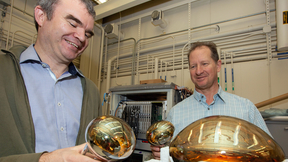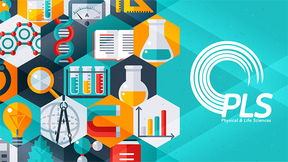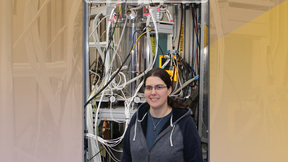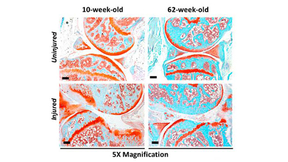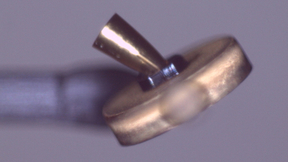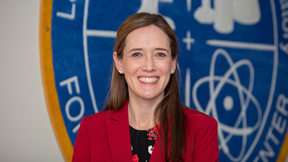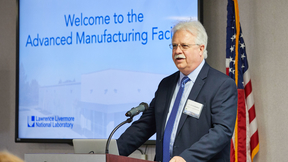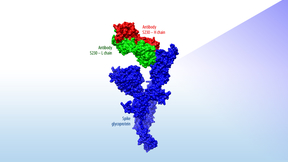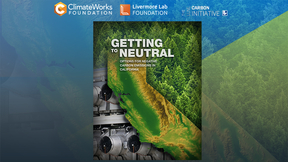Back
Physical and Life Sciences
Seeing metal interfaces as they transform
The regions separating individual crystals in a material are notorious defects, spoiling the simple arrangement of atoms within the crystals. To improve the understanding of how those defects, called grain boundaries, create stronger and more durable materials, a team of scientists from Lawrence Livermore National Laboratory (LLNL) and Max-Planck-Institut für…
Laboratory researchers describe how antineutrino detectors could aid in nuclear nonproliferation efforts
A tiny, invisible particle could offer help for a big problem — the threat of nuclear proliferation. For more than six decades, scientists have been developing instruments for fundamental physics that can detect antineutrinos, particles that have no electric charge, almost no mass and easily pass through matter. Antineutrinos are emitted in vast quantities by nuclear…
NIF-JLF User Group 2020 Meeting
At the recent 2020 NIF and Jupiter Laser Facility (JLF) User Group meeting, we ask attendees to tell us why the annual conference is important for their work and for the exciting future of high energy density science.
Computers, physics, math shape groundbreaking career
Growing up in the suburbs of Melbourne, Australia, Lawrence Livermore National Laboratory (LLNL) scientist Joe Morris spent much of his time conducting home experiments with chemicals, test tubes and pipettes before moving on to electronics and computer programming. “My parents taught me to be curious, seek answers and be a free thinker,” Morris said of his mother and…
Machine learning accelerates high-performance materials development and deployment
Lawrence Livermore National Laboratory (LLNL) and its partners rely on timely development and deployment of diverse materials to support a variety of national security missions. However, materials development and deployment can take many years from initial discovery of a new material to deployment at scale. An interdisciplinary team of LLNL researchers from the Physical…
Flash droughts present challenge for warning system
Flash droughts are a type of extreme event distinguished by rapid intensification of drought conditions with severe impacts. They unfold on subseasonal to seasonal timescales (weeks to months), presenting a new challenge for improving predictions of when flash droughts occur. In new research published in the March 2 edition of Nature Climate Change, a multi-institutional…
Lab physicist awarded 2020 dissertation prize
Lawrence Livermore National Laboratory (LLNL) physicist Natalie Hell has been awarded the 2020 Dissertation Prize from the Laboratory Astrophysics Division (LAD) of the American Astronomical Society (AAS). Hell received the prize for her outstanding experimental doctoral dissertation in laboratory astrophysics. Her thesis, “Benchmarking Transition Energies and Emission…
Injury-induced joint degeneration accelerated in older animals
Aging and injury are two major risk factors for osteoarthritis (OA), yet very little is known about how aging and injury interact and contribute to OA disease development. In a new study, researchers from LLNL, UC Merced, and UC Davis Medical Center examined age- and injury-related molecular changes in mouse knee joints that could contribute to OA. Using RNA sequencing,…
Observations of melting metal at the picosecond scale
For the first time, Lawrence Livermore National Laboratory (LLNL) scientists and collaborators have observed the shock melting and refreezing of a metal (zirconium) at the picosecond scale (trillionths of a second). Melting and freezing are some of the most common processes but can be difficult to understand since the fundamental mechanisms occur on near-atomic and…
Glacier retreat study helps predictions of climate future
Tropical glaciers in Africa and South America began their retreat simultaneously at the end of the last ice age about 20,000 years ago, according to a recent study by a multi-institutional research team that includes Lawrence Livermore National Laboratory’s (LLNL) Susan Zimmerman. The finding of synchrony in ice retreat across the global tropics clarifies how the low…
X-ray flashes shed light on sleeping sickness cure
Using ultra-bright X-ray flashes, a Lawrence Livermore National Laboratory (LLNL) scientist and international collaborators tracked down a potential target for new drugs against sleeping sickness. The scientists decoded the detailed spatial structure of a vital enzyme of the parasite Trypanosoma brucei. The result provides a possible blueprint for a drug that specifically…
Focusing target gives powerful boost to NIF’s ARC
Lawrence Livermore National Laboratory (LLNL) scientists have employed compound parabolic targets to achieve relativistic effects associated with significantly greater laser intensities. This innovation has substantially expanded the experimental capabilities of the National Ignition Facility’s (NIF) Advanced Radiographic Capability (ARC) laser. The targets, called…
Forensic scientist wins 'outstanding' early career award
A chemist who is the director of Lawrence Livermore National Laboratory’s (LLNL) Forensic Science Center is the recipient of the 2020 “Outstanding Early Career Achievement in Forensic Science Award.” The award, given to LLNL’s Audrey Williams, is presented annually by the American Academy of Forensic Sciences (AAFS) Past Presidents Council. This year’s award will be…
Nutrients limit carbon uptake to slow climate change
Nitrogen and phosphorus found in soils are limiting the amount of carbon uptake stored in plants and soils, but maps of where this occurs across the globe are lacking. A Lawrence Livermore National Laboratory (LLNL) scientist and international collaborators have developed a framework for testing nutrient limitations and a benchmark of nitrogen (N) and phosphorus (P)…
Lab researchers develop 3D ‘brain-on-a-chip’ device capable of long-term recording of neural activity
Lawrence Livermore National Laboratory (LLNL) engineers and biologists have developed a “brain-on-a-chip” device capable of recording the neural activity of living brain cell cultures in three dimensions, a significant advancement in the realistic modeling of the human brain outside of the body. In a paper published by the journal Lab on a Chip, LLNL researchers report on…
Open for business: NNSA, LLNL celebrate the dedication of new Advanced Manufacturing Laboratory
Officials from the National Nuclear Security Administration (NNSA) and Lawrence Livermore National Laboratory (LLNL) gathered with elected leaders and industry professionals recently to dedicate and tour the Advanced Manufacturing Laboratory, a new collaborative hub intended to spur public-private partnerships. The $10 million, 14,000-square-foot facility, located in the…
Lawrence Livermore researchers release 3D protein structure predictions for the novel coronavirus
As global concern continues to rise about a novel coronavirus spreading from China, a team of Lawrence Livermore National Laboratory (LLNL) researchers has developed a preliminary set of predictive 3D protein structures of the virus to aid research efforts to combat the disease. The team’s predicted 3D models, developed over the past week using a previously peer-reviewed…
New Lab report outlines ways California could reach goal of becoming carbon neutral by 2045
Lawrence Livermore National Laboratory (LLNL) scientists have identified a robust suite of technologies to help California clear the last hurdle and become carbon neutral – and ultimately carbon negative – by 2045. This groundbreaking study, “Getting to Neutral: Options for Negative Carbon Emissions in California,” was conducted as part of LLNL’s expansive energy programs…
3D-printed aerogel electrodes boost energy storage
A team of Lawrence Livermore National Laboratory (LLNL) scientists and collaborators from the University of California, Santa Cruz (UCSC) and Sun Yat-Sen University have developed a new class of aerogel electrodes with a simultaneous boost in energy and power density. The research could be a boon for the energy storage industry. “This is the first example in which we were…
LLNL, Livermore Lab Foundation, ClimateWorks to unveil report on California’s road to carbon neutrality
WHO: Scientists and leaders from Lawrence Livermore National Laboratory in collaboration with the Livermore Lab Foundation and ClimateWorks WHAT: LLNL will host a briefing to unveil the new report, “Getting to Neutral: Options for Negative Carbon Emissions in California,” which identifies a robust suite of technologies to help California clear the last hurdle and become…



